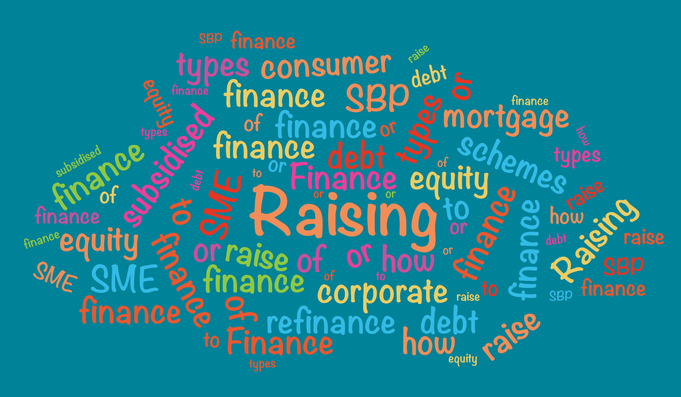Raising Finance
Raising Finance: A Guide for Women Entrepreneurs and SMEs in the current times
Raising finance is a critical step for business growth, yet it remains one of the most challenging for many entrepreneurs—especially women and SMEs (Small and Medium Enterprises). Whether you're launching a startup or expanding an established venture, understanding your financing options can make or break your success.
 Raising Finance-A Basic Guide for Women
Raising Finance-A Basic Guide for WomenA Guide for Women Entrepreneurs and SMEs in the current times
A brief guide book to consolidate all the information contained in the pages Raising Finance, Types of Finance, How to Raise Finance and the Finance Process can be accessed by downloading the following eBook:
Raising Finance - A Basic Guide for Women (as well as for all SMEs)
This basic guide breaks down modern finance strategies, with a special focus on women-owned businesses and small enterprises navigating today’s economic and regulatory climate.
Raising Finance - Why is it Still a Hurdle—Especially for Women
Globally, women face disproportionate barriers in accessing finance. From lower property ownership rates to limited credit histories, systemic hurdles often make it harder for women to secure loans or attract investment.
Even in the current day and age, many women entrepreneurs lack access to formal networks, financial training, or mentors—factors that limit exposure to equity financing, bank funding, or government grants.
Empowering women to raise finance effectively is not only a gender issue—it’s an economic imperative.

Raising Finance - Debt or Equity
Raising finance for business always remains a daunting task for most of the businesses. For women owned businesses the issue becomes even more difficult as most of them are not aware of how to get financing and to have financial management to manage the same and also because the collateral required to secure loans is usually not in the name of the entrepreneur concerned.
Here we have used the word 'business' but covers both entrepreneurs and professionals as both require funding at one point or the other.
Step 1: Assess Your Financial Needs
Before you start raising finance, clearly define why you need funding and how much you really need:
- Are you building a product prototype?
- Expanding your team or production?
- Launching a new location or entering new markets?
Don’t overborrow or underfinance. Too much capital can lead to waste, while too little can stall your business before it gains traction. Use realistic cash flow projections and identify if your need is short-term (working capital) or long-term (asset acquisition, expansion).
Tip: Avoid using personal or consumer loans (like credit cards) for business purposes. These come with high-interest rates and personal risk.
Step 2: Understand Your Options – Debt vs. Equity
Debt Financing
Debt involves borrowing money that must be repaid with interest. It's ideal for business owners who want to maintain full control and ownership.
Common options include:
- Bank Loans: These remain the most traditional route. For instance, Maira, who runs a boutique organic food brand, secured a loan from a commercial bank under the State Bank of Pakistan’s subsidized SME finance scheme. She used it to expand her distribution to three cities without giving up any ownership.
- Microfinance: Especially valuable for women in rural areas or informal sectors. Nazia, a home-based clothing business owner, took a PKR 200,000 loan from a microfinance institution to purchase a sewing machine and fabric in bulk—doubling her income within a year.
- Leasing: Useful for acquiring expensive assets without full upfront payment. Zainab, who runs a small printing business, leased a high-speed printer through a finance company, making monthly payments instead of a hefty one-time purchase.
Pros: Retain 100% ownership; interest is tax-deductible.
Cons: Requires regular repayments; collateral may be needed.
Equity Financing
Equity financing means selling a share of your business in exchange for capital. This is ideal when you're scaling quickly or launching an innovation-driven startup.
Examples include:
- Angel Investors: Ayesha, a tech entrepreneur with a women’s health app, received $20,000 from a local angel investor who not only funded the pilot launch but also introduced her to key healthcare partners.
- Venture Capital (VC): Ameena founded a women-led agri-tech platform connecting farmers to city buyers. With proven traction, she secured VC funding that helped her scale operations across the province, expand her tech team, and access export markets.
- Crowdfunding: Fatima, a sustainable fashion designer, raised funds via a local crowdfunding platform by pre-selling her handmade clothing to conscious buyers. The campaign helped her fund the production of her first collection without any debt.
Pros: No repayment pressure; access to strategic guidance.
Cons: Partial ownership and decision-making may be shared.
Tip: Look into gender-lens investors and global funds supporting women, such as We-Fi, SheEO, and Women’s World Banking.
Step 3: When to Raise Finance
There are specific times when you should raise funds and from which suitable sources. For example if you are at the initial idea stage, you do not require large amounts. What you need is barely some savings. Once you have decided on a certain product, review the 'Product Development' segment and finalize your initial concept to develop a prototype of your product.
After you have prepared your prototype, decide to go into a small trial run based on the optimal minimum quantity. For this again you do not require large amounts you can manage with a small saving or with borrowed funds from friends or family.
Once your trial run takes off and the market accepts your product then plan on your larger preferably order-based quantity. You would need some financing for raw material, labour and if you are manufacturing, then you require financing for equipment. Start with a small number of equipment for which you can raise money through 'Lease Finance'. In that way you won't require additional equity.
Timing matters. Here’s a simplified roadmap:
- Idea Stage: Use personal savings or small contributions from friends/family.
- Prototype Stage: Explore government grants or incubator support.
- Trial Production & Market Testing: Seek angel funding or soft loans.
- Growth & Scale: Lease equipment, access bank loans or VC funding.
- Expansion & Maturity: Reinvest profits, consider long-term loans or equity dilution.
 When to Raise Finance & From Where
When to Raise Finance & From WhereIf you have to raise a short term loan i.e. for one year, then go for Working Capital Financing to manage day to day expenses. Commercial Banks offer Running Finance Facility that can be used as required and replenished with the trade cycle.
There are many other schemes for the entire SME sector in which the segment of women entrepreneurs is also covered.
Let's understand the different types of financing that are available to fund your business , how to raise finance and the finance process following these links below...
Step 4: Non-Bank Financing for Women and SMEs
In this decade, raising finance without traditional banks is more viable than ever:
- Digital Lending Platforms: Quick access to small loans with fewer hurdles.
- Peer-to-Peer (P2P) Lending: Borrow directly from individuals via online platforms.
- Grants for Women Entrepreneurs: Local and international grants that don’t require repayment.
- Trade Credit: Negotiate with suppliers for delayed payments—boosting your cash flow.
Explore: Pakistan’s Fintech lenders that offer flexible credit to small businesses.
Step 5: Build Your Financial Capability
Knowing how to raise finance is one thing—managing it is another.
To grow responsibly:
- Take financial literacy courses (via Coursera, edX, or local institutions).
- Use accounting software like QuickBooks, Xero, or Tajir.
- Join women entrepreneur networks for learning and mentorship.
A financially aware business owner is more credible to lenders and investors alike.
Final Thoughts: Your Roadmap to Smart Financing
Raising finance isn’t just about capital—it's about strategy. Whether you're a woman solopreneur or a growing SME, there are more inclusive and accessible funding avenues than ever before.
✅ Assess your needs
✅ Choose the right type of financing
✅ Time your fundraising smartly
✅ Explore non-bank options
✅ Build financial capability
📘 Free Download: Raising Finance – A Basic Guide for Women and SMEs
Includes funding checklists, success stories, and pitch templates.
- Home
- Knowledge Base
- Raising Finance


